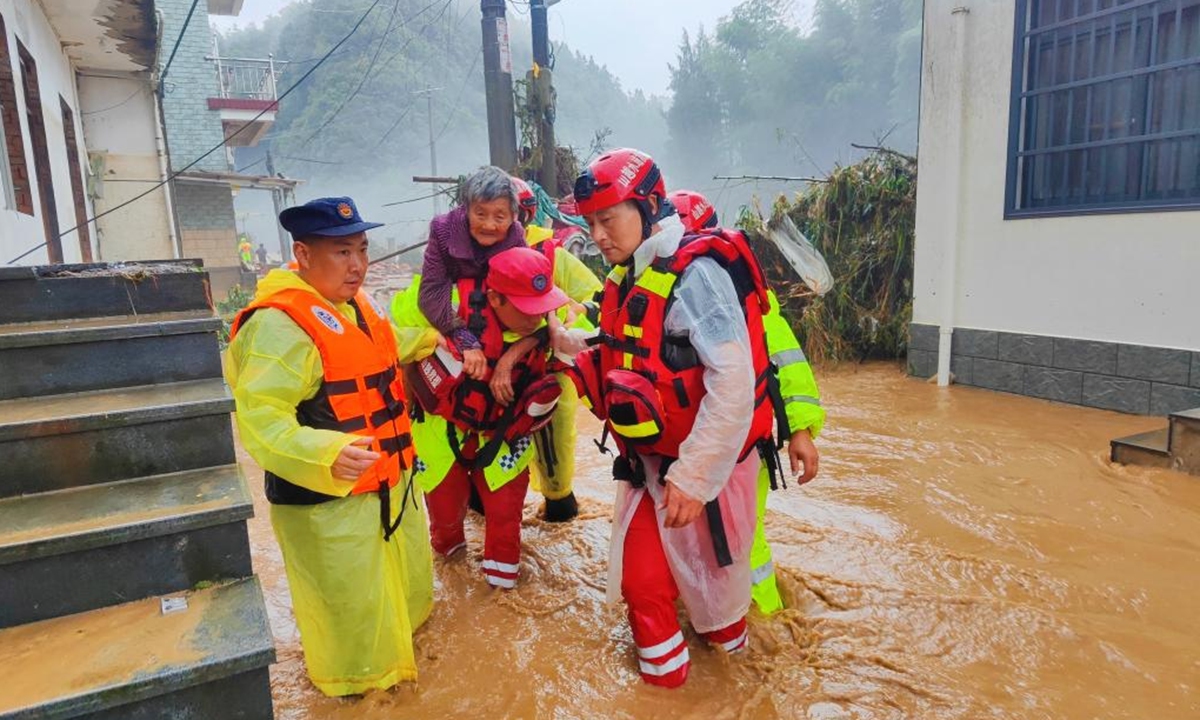
Rescuers transfer a flood-affected resident in Shexian County of Huangshan, East China's Anhui Province, June 20, 2024. In Huangshan City of east China's Anhui Province, due to intense downpours, some 2,110 residents had been relocated as of 9 a.m. Thursday, according to the local flood control and drought relief headquarters. Photo: Xinhua
Huangshan, a popular tourism city in East China's Anhui Province, has activated its emergency Level II response for flood control, as the city has been hit by heavy rain since Tuesday, with more than 10,900 people being relocated urgently, according to Anhui emergency management authorities on Friday.
Local Huangshan authorities have mobilized fire trucks and boats to evacuate and rescue over 2,400 stranded residents, and more than 900 emergency rescue teams have been dispatched to the frontline of the rescue effort.
Starting from 8 pm on Tuesday, Huangshan experienced continuous heavy rainfall accompanied by thunderstorms and strong winds. From Wednesday to Thursday, average rainfall in the city was 176.4 millimeters, with the highest recorded rainfall reaching 405.7 millimeters. Heavy rain led to rapid rises in river water levels, severe flooding in some areas, and secondary disasters such as fallen trees and landslides, according to authorities.
From Tuesday to Friday, a total of 944 hydrometric stations in Anhui recorded precipitation exceeding 100 millimeters, with Xucun village in Shexian county recording the highest level, reaching 524 millimeters, according to the Anhui meteorological authorities.
The National Meteorological Center on Friday morning maintained a yellow alert for rainstorms in regions including Anhui and Central China's Hubei Province.
As of 11:30 pm on Thursday, 179,000 people in Huangshan had been affected by the extreme weather, with over 10,400 hectares of crops damaged, and 55 houses from 27 households collapsing, with direct economic losses exceeding 500 million yuan ($68.82 million). Additionally, nine national and provincial highways and 41 rural roads were blocked by flooding, leading to the suspension of 170 passenger transportation routes, as well as all water transport services, the authorities noted.
A local resident surnamed Jin living in central Huangshan told the Global Times on Friday that the water has mostly receded, and that the city has started to recover.
Wang, a local businessman in Shexian county, one of the most affected regions in Huangshan, told the Global Times on Friday that it seems that the flooding this time is more serious than the flooding four years ago. "The shops along the street were all impacted by the flooding to varying degrees in the county. Shop owners were busy on post-disaster reconstruction, cleaning up mud today," Wang said.
Huangshan city authorities established a 24-hour hotline to ensure that people's requests are promptly addressed and resolved.
Huanxiu bridge, one of the oldest of its kind in Huangshan, had also been damaged by the flooding on Thursday, according to media reports. Officials from the local cultural relics authorities have arrived at the village to inspect the damage to key cultural relics.
Elsewhere, in Pingyuan county, South China's Guangdong Province flooding has killed 38 people and two are still missing as of 3 pm on Friday. The total precipitation in the county has reached 1,221.6 millimeters since April 4, which is twice the normal amount for the same period, according to China Central Television on Friday.
Chinese authorities
have been making full efforts in combating flooding and drought in northern and southern regions recently. The Lijiang River has experienced its largest flood since 1998. Qinzhou, South China's Guangxi Zhuang Autonomous Region, upgraded rainstorm warning from orange to red on Friday.
China's ministries of finance and transport urgently allocated 105 million yuan to support seven provincial-level regions, including Guangdong, Guangxi, and East China's Zhejiang Province, in carrying out emergency repairs on highways, to ensure the safety and smoothness of highways during the flood season, according to media reports.




